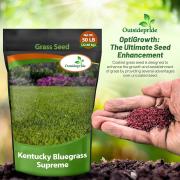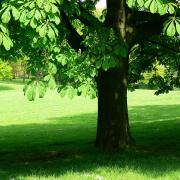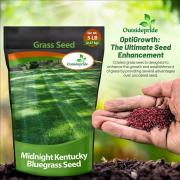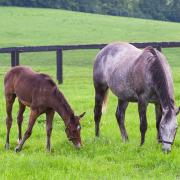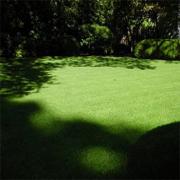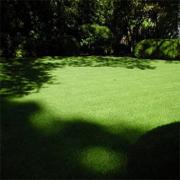Most common inhabitants are usually crickets, beetles, grasshoppers, millipedes, and worms. Some of these insects feed on the grass blades, some feed on grass roots, and some feed on each other. Usually, Kentucky Bluegrass will grow faster than the average insect can eat and you don’t have to worry. There are, however, a few classes of insects that can increase in populations large enough to harm your lawn. These can also be treated fairly easily with soil insecticides and natural products like BT. The best time for a once-a-year insect treatment is in late July or early August.
Insect damage is often defined as an irregularly shaped patch of discolored or brown grass in lawn. If you take a drive around town, you will probably pass countless lawns that fit that description. The problem is, only around ten in a thousand lawns will have an insect problem. Lawns are finicky and irregular brown patches pop up for different reasons. One of the most common is drought. You might think your lawn in evenly watered but even a slight rise or a different soil texture can alter the amount of water that penetrates the soil. When you think you have an insect problem, it is more productive to first look for another cause first. Then, wait to see if the troubled lawn area expands. Only then should you worry about treating with soil insecticide. Here is a list of problem insects.
White grubs: These are one of the most common insect pests for Kentucky Bluegrass grass. White grubs are the larval, soil-inhabiting form of several different types of beetles. The most notorious beetle in the South Is the Japanese Beetle. White grubs can be controlled with a granular soil insecticide applied in late July/early August according to the labeled directions. Milky Spore is a natural product that effectively kills the white grubs. The effective ingredient in Milky Spore (Bacillus popilliae) will remain active in your soil for many years – a good long term solution to white grubs
Billbugs: are black, hard-shelled beetled with a curved snout like an elephant trunk. You may see them moving around in the spring as they prepare to lay their eggs. The eggs hatch into legless white grubs that feed on Kentucky Bluegrass roots during the late spring and summer. Damage usually appears as circular areas of brown or yellowing grass. Billbugs can be controlled with a soil insecticide approved for Kentucky Bluegrass grass.
Armyworms: Armyworms are another type of larval worm that feed in masses throughout the day and night. They move quickly and can literally devour a lawn. Keep a lookout beginning in the late spring and through the growing season. Young larvae eat the edges of grass blades white the mature larvae eat the entire blade. Armyworms usually affect an entire sub-division at a time, so listen to our neighbors and state agencies for "Armyworm alerts". The worst outbreaks of large populations usually occur from July to October. If found, apply a soil insecticide approved for use on Kentucky Bluegrass grass. Damaged lawns can usually be revived with careful irrigation.
Chinch bugs: A notorious problem in the South. Infected lawns usually have irregular patches of yellowing or wilted grass in sunny areas. Chinch bug problems are most common in July through September. To confirm their presence, cut the top and bottom from a coffee can and bound it several inches into the yellow grass. Fill the insecticide of the can with several inches of water and maintain the water level for 5 minutes. The chinch bugs will float to the surface. Once you have located them, treat the area with a soil insecticide labeled for control of chinch bugs and approved for Kentucky Bluegrass grass.
Mole crickets: Mole crickets are a major concern in the lower South in sandy soils. These horrendous burring crickets tunnel through the soil at night, loosening the sandy soil and disrupting grass roots. Mole crickets are active throughout the growing season but are most common when night air temperatures remain above 60 degrees. Damage usually appears as if someone cultivated areas of your lawn. They can be controlled with a soil insecticide labeled for control of mole crickets and approved for use on Kentucky Bluegrass grass.
Moles: if moles are tunneling through your lawn, they are probably after white grubs. Treatment for white grubs in late July/early August is likely the easiest way to get rid of moles.
All Products
My Cart
Account
Menu
-
CLOVERS
Alsike Clover Seeds Arrowleaf Clover Seeds Berseem Clover Seeds Clover King Deer Food Plot Seed Crimson Clover SeedsCrimson Clover Seeds - White Fixation Balansa Clover Ladino Clover Seeds Lespedeza Capitata Seeds Miniclover Seeds
-
COVER
CROPS - DEER
-
FLOWERS
Abutilon Seeds Acanthus Seeds Aconitum Seeds African Daisy Seeds (12) Agastache Seeds (8) Ageratum Seeds (5) Agrostemma Seeds (3) Ajuga Seeds Allium Cernuum Seeds Alstroemeria (2) Alternanthera Seeds (1) Amaranthus Seeds (11) Ammobium Alatum Seeds Anemone Seeds (3) Angelonia Seeds (7) Annual Short Seeds Sunburst Anthemis Seeds (3) Anthyllis Seeds Arenaria Montana Seeds Armeria Seeds (2) Aruncus Seeds (2) Asarina Seeds (4) Asparagus Fern Seeds (2) Asparagus Pea Vegetable Seeds Aster Seeds (32) Astilbe Seeds (3) Bacopa Seeds (3) Balloon Flower Seeds (3) Baptisia Seeds (2) Bee Balm Seeds (5) Begonia Seeds (18) Bellis Seeds (4) Bergenia Cordifolia Seeds Bird of Paradise Flower Seeds Bishop's Flower Seeds Blue-Eyed Grass Seeds Blue Daisy Seeds Blue Flower Seeds Brachycome Seeds Browallia Seeds Bugloss Seeds Bupleurum Seeds Bur Marigold Seeds Burning Bush Seeds Butterfly Bush Seeds (1) Butterfly Flower Seeds Butterfly Weed Seeds (7) Cactus Seeds Calendula Seeds (9) California Bluebell Seeds Campanula Seeds (9) Canna Seeds (6) Cardinal Climber Seeds Cardiospermum Seeds Carnation Seeds (13) Castor Beans Seeds (5) Celosia Seeds (6) Cerinthe Seeds - Major Chenopodium Seeds Chicory Seeds Chinese Houses Seeds Chocolate Flower Seeds Christmas Rose SeedsChrysanthemum Seeds (11) Cimicifuga Seeds - Ramosa Cineraria Seeds (1) Clarkia Wildflower Seeds Clematis Seeds Cleome Seeds (5) Cobaea Seeds (3) Coffea Arabica Seeds Coleus Seeds (18) Columbine Seeds (11) Coreopsis Seeds (4) Cornflower Seeds (16) Cosmos Seeds (26) Cotton Seeds - Levant Craspedia Globosa Seeds Creeping Zinnia Seeds Crocosmia Seeds Crossandra Seeds (2) Cupids Dart Seeds (2) Cyclamen Seeds (3) Cynoglossum Seeds (2) Cypress Vine Seeds (4) Dahlberg Daisy Seeds Dahlia Seeds (14) Dame's Rocket Seeds Datura Metel Seeds (4) Delphinium Seeds (12) Dianthus Seeds (19) Dicentra Eximia Seeds Echinacea Seeds (9) Echium Seeds (3) Edelweiss Seeds Erigeron Seeds (2) Eryngium Seeds (3) Eucalyptus Seeds (2) Eupatorium Seeds (2) Euphorbia Seeds (1) Flax Seeds (5) Forget-me-not Seeds (4) Four O'Clock Seeds (9) Foxglove Seeds (10) Freesia Seeds (1) Gaillardia Seeds (9) Gaura Seeds Gayfeather Seeds Geranium Seeds (11) Gerbera Seeds (13) Geum Seeds (3) Gilia Seeds Globe Thistle Seeds (2) Gloxinia Seeds Godetia Seeds (5) Gomphrena Seeds (5) Green Flowers Seeds Gypsophila Seeds (4) Heather Seed Helenium Seeds (3) Helichrysum Seeds (5) Heliopsis Seeds - Summer Sun Heliotropium Seeds - Marine Helipterum Seeds (2) Heuchera Seeds (4) Hibiscus Seeds (7)Hollyhock Seeds (29) Hops Seeds Horehound Seeds Hosta Seeds - American Hyacinth Bean Seeds (3) Hypoestes Seeds (6) Illinois Bundleflower Seeds Impatiens Seeds (29) Iris Missouriensis Seeds Jupiter's Beard Seeds (3) Kenilworth Ivy Seeds Lace Flower Seeds Lacy Phacelia Seeds Lady's Mantle Seeds Lamb's Ear Seeds (3) Larkspur Seeds (6) Laurentia Seeds (1) Leadplant Seeds Leptosiphon Mix Seeds Lespedeza Capitata Seeds Lewisia Seeds (2) Lily of the Nile Seeds Limnanthes Douglasii Seeds Linaria Alpina Seeds Lisianthus Seeds (2) Luffa Seeds Lupine Seeds (6) Lychnis Seeds (4) Malope Mix Seeds Marigold Seeds (29) Melampodium Derby Seeds Mentzelia Lindleyi Seeds Mexican Petunia Seeds (1) Mexican Sunflower Seeds (4) Mignonette Seeds (1) Milkweed Seeds (9) Mimosa Pudica Seeds Mimulus Seeds (2) Mina Lobata Seeds Money Plant Seeds (2) Moonflower Flower Seeds Morning Glory Seeds (22) Nasturtium Seeds (23) Nemesia Seeds (2) Nemophila Seeds (3) Nepeta Seeds (4) Nicotiana Seeds (7) Nigella Seeds (4) Obedient Plant Seeds (1) Ohio Spiderwort Seeds Orange Flowers Seeds Ornamental Cabbage Seeds Ornamental Kale Seeds Pansy Seeds (48) Passion Flower Seeds Peanut Seeds Pennyroyal Seeds Penstemon Seeds (8) Pentas Seeds (4) Peony Seeds (8) Petunia Seeds (40) Phlox Seeds (10) Physalis Seeds (2)Pink Flowers Seeds Plectranthus Seeds (2) Polemonium Seeds Polygonum Capitatum Seeds Poppy Seeds (32) Potentilla Seeds (5) Primrose Seeds (26) Ptilotus Exaltatus Seeds Purple Loosestrife Seeds Ranunculus Seeds (2) Ratibida Seeds (2) Red-hot Poker Seeds (1) Red Flowers Seeds Rehmannia Angulata Seeds Rhodochiton Atrosanguineus Seeds Rosa Chinensis Seeds Rose Mallow Seeds (4) Rudbeckia Seeds (14) Safflower Seeds (3) Salpiglossis Seeds Salvia Seeds (9) Saponaria Seeds (3) Scabiosa Seeds (8) Scarlet Runner Beans Vegetable Seeds Senna Seeds Siberian Wallflower Seeds Silene Seeds (2) Silphium Seeds (1) Slipper Flower Seeds (1) Snapdragon Seeds (6) Snow in Summer Seeds Society Garlic Seeds Solanum Seeds (1) Solidago Seeds - Goldenrod St. John's Wort Seeds Statice Seeds (5) Stock Seeds (5) Stokesia Seeds (1) Sunflowers Seeds (9) Sweet Peas Seeds (24) Teasel Seeds Texas Bluebonnet Seeds Thunbergia Seeds (6) Tidy Tips Seeds Toadflax Seeds Torenia Seeds (6) Umbrella Plant Seeds Ursinia Anthemoides Seeds Venidium Seeds Venus Flytrap Seeds Verbascum Seeds (5) Veronica Seeds (5) Viola Seeds (48) Viscaria Seeds (2) White Flowers Seeds Wintergreen Seeds Xeranthemum Annuum Seeds Yarrow Seeds (7) Yellow Flowers Seeds Yucca Seeds (4) Zea Mays Seeds Zinnia Seeds (49) Zizia Aurea Seeds
-
GRASS
Blue Grama Native Grass Seed Bluestem Seeds - Big Bluestem Seeds - Little Indian Grass Seeds Northeast Native Grass Seed MixBlue-Eyed Grass Seeds Blue Fescue Seeds Blue Hair Grass Seeds Bluestem Seeds - Big Bluestem Seeds - Little Carex Seeds (3) Cat Grass Seeds Cloud Grass Coix Seeds Hordeum Jubatum Seeds Indian Grass Seeds
-
GROUND
COVERAcaena Seeds (2) Ajuga Seeds Alyssum Seeds (13) Anacyclus Garden Gnome Annual Short Seeds Sunburst Antennaria Seeds (2) Anthyllis Seeds Arenaria Montana Seeds Bergenia Cordifolia Seeds Candytuft Seeds (4) Christmas Rose Seeds Common Veronica Seeds Corsican Mini Mint SeedsCreeping Thyme Seeds (4) Creeping Zinnia Seeds Crown Vetch Seeds Dahlberg Daisy Seeds Dichondra Seeds (3) Edelweiss Seeds Gazania Seeds (21) Herniaria Glabra Seeds Ice Plant Seeds (6) Irish Moss Seeds Kenilworth Ivy Seeds Leptosiphon Mix Seeds Limnanthes Douglasii Seeds -
HERBS
Agastache Seeds - Rugosa Angelica Seeds Anise Seeds Artemisia Seeds (3) Arugula Herb & Microgreens Seeds Astragalus Seeds Basil Seeds (7) Blessed Thistle Seeds Borage Seeds (2) Burdock Seeds Calamintha Seeds (3) Capparis Spinosa Seeds Cardoon Seeds Catnip Seeds Chamomile Seeds (2) Chervil Herb & Microgreens Seeds Chia Seeds Chives Seeds (2) Cilantro Herb & Microgreens Seeds Clary SeedsCoix Seeds Comfrey Seeds Cumin Seeds (2) Daikon Radish Microgreens Seeds Dandelion Seeds Dill Herb & Microgreens Seeds Echinacea Seeds - Purple Coneflower Edelweiss Seeds Eupatorium Seeds - Boneset Fennel Seeds Fenugreek Herb & Microgreens Seeds Feverfew Seeds Gentian Seeds (2) Germander Seeds Ginseng Seeds Goji Berry Seeds Horehound Seeds Hyssop Seeds (3) Lavender Seeds (6) Lemon Balm (2)Lemon Catnip Seeds Lemon Grass Seeds Licorice Seeds Lovage Vegetable Seeds Marigold Licoboost Seeds Marjoram Seeds Marsh Mallow Seeds Mentha Seeds (4) Mexican Mint Seeds Milk Thistle Seeds Motherwort Seeds Mustard Seeds (3) Oregano Seeds (2) Oyster Plant Seeds Perilla Frutescens Seeds Plantain Seeds (2) Purslane Seeds (6) Rosemary Seeds Rue Seeds Sage SeedsSalad Burnet Seeds Savory Seeds (2) Senna Seeds Skullcap Seeds Society Garlic Seeds Sorrel Herb & Microgreens Seeds Spikenard Seeds Stevia Seeds (2) Stinging Nettle Seeds Tansy Seeds Thyme (2) Toothache Plant Seeds Valerian Seeds Verbascum Seeds - Mix Viola Seeds - Johnny Jump Up Watercress Seeds Woodruff Seeds (1)
-
WILD
FLOWERSAnnual Short Seeds Sunburst Annual Sun Wild Flower Seed Mix Balcony Wild Flower Seed Beneficial Insectary Wild Flower Seed Mix Birds & Butterfly Wild Flower Seed Mix Deer Proof Wild Flower Seed Mix -
DROUGHT
TOLERANT -
VEGETABLES
































